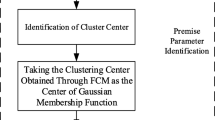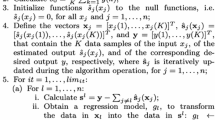Abstract
The structure of the extended fuzzy basis function network (EFBFN) is firstly proposed, and the least squares (LS) method is used to design it by fixing the widths of the hidden units in EFBFN. Then, to enhance the performance of the obtained EFBFN ulteriorly, a novel evolutionary algorithm based on LS and the hybrid of evolutionary programming and particle swarm optimization (LS-EPPSO) is proposed, in which we use EPPSO to tune the parameters of the premise part in EFBFN, and the LS algorithm to decide the consequent parameters in it simultaneously. The enhanced EFBFN whose parameters are refined automatically using LS-EPPSO is thus called adaptive EFBFN. In the simulation part, the proposed method to construct AEFBFN is employed to model a three input nonlinear function and to predict a chaotic time series. Comparisons with some typical fuzzy modeling methods and artificial neural networks are presented and discussed.






Similar content being viewed by others
References
Cordon O, Gomide F, Herrera F et al (2004) Ten years of genetic fuzzy systems: current framework and new trends. Fuzzy Set Syst 141:5–31
Jang JSR, Sun CT, Mizutani E (1993) ANFIS: adaptive-network-based fuzzy inference system. IEEE Trans Syst Man Cybern 23:665–685
Sanchez L, Otero J (2004) A fast genetic method for inducting descriptive fuzzy models. Fuzzy Set Syst 141:33–46
Delgado MR, Zuben FV, Gomide F (2004) Coevolutionary genetic fuzzy systems: a hierarchical collaborative approach. Fuzzy Set Syst 141:89–106
Juang CF (2004) A hybrid of genetic algorithm and particle swarm optimization for recurrent network design. IEEE Trans Syst Man Cybern B Cybern 34:997–1006
Lee CW, Shin YC (2003) Construction of fuzzy systems using least-squares method and genetic algorithms. Fuzzy Set Syst 137:297–323
Eberchart R, Kennedy J (1995) A new optimizer using particle swarm theory. In: Proceedings of the international symbosium on micro machine and human science, Nagoya, Japan, pp 39–43
Wang LX, Mendel JM (1992) Fuzzy basis functions, universal approximation, and orthogonal-least squares learning. IEEE Trans Neural Netw 3:807–814
Mitra S (2004) Fuzzy radial basis function network: a parallel design. Neural Comput Appl 13:261–267
Nie J, Linkens DA (1993) Learning control using fuzzified self-organizing radial basis function network. IEEE Trans Fuzzy Syst 1:280–287
Harpham C, Dawson CW, Brown MR (2004) A review of genetic algorithm applied to training radial basis function network. Neural Comput Appl 13:193–201
Sun YF, Liang YC, Zhang WL et al (2005) Optimal partition algorithm of the RBF neural network and its application to financial time series forecasting. Neural Comput Appl 14:36–44
Górriz JM, Puntonet CG, Salmerón M et al (2004) A new model for time-series forecasting using radial basis function network and exogenous data. Neural Comput Appl 13:101–111
Chen S, Cowan CFN, Grant PM (1991) Orthogonal least squares learning algorithm for radial basis function networks. IEEE Trans Neural Netw 2:302–309
Cho HL, Oh SY, Choi Voges DH (1998) A new evolutionary programming approach based on simulated annealing with local cooling schedule. In: Proceedings of the 1998 IEEE evolutionary computation conference, pp 598–602
Gao F, Li M, Wang F, Wang B, Yue P (1999) Genetic algorithms and evolutionary programming hybrid strategy for structure and weight learning for multilayer feedforward neural networks. Ind Eng Chem Res 38:4330–4336
Sarkar M, Yegnanarayana B, Khemani D (1997) A clustering algorithm using evolutionary programming. Patten Recognit Lett 18:975–986
Cao YJ, Wu, QH (1999) Applying evolutionary programming to robust control systems design and analysis. In: Proceedings of the 1999 congress on evolutionary computation, p 3
Ye B, Guo CX, Cao YJ (2004) Short-term load forecasting using a new fuzzy modeling strategy. In: Proceedings of World Congress on Intelligent Control and Automation 6:5045–5049
Cao YJ (1997) Eigenvalue optimisation problems via evolutionary programming. Electron Lett 33:642–643
Shi Y, Eberhart RC (1998) Parameter selection in particle swarm optimization. In: The 7th annual conference on evolutionary programming, San Diego, 7:591–600
Eberhart RC, Shi Y (1998) Comparison between genetic algorithms and particle swarm optimization. In: The 7th annual conference on evolutionary programming, San Diego, 7:611–616
Ye B, Zhu CZ, Guo CX, Cao YJ (2005) Generating extended fuzzy basis function network using hybrid algorithm. In: 2nd international conference on FSKD, 2005. LNAI 3613:79–88
Ye B, Zhu CZ, Guo CX, Cao YJ (2005) Fuzzy modeling strategy for control of nonlinear dynamical systems. In: 2nd international conference on FSKD, 2005. LNAI 3613:882–885
Takagi T, Sugeno M (1985) Fuzzy identification of systems and its application. IEEE Trans Syst Man Cybern 15:116–132
Ye B, Guo CX, Cao YJ (2004) Identification of fuzzy model using evolutionary programming and least squares estimate. In: Proceedings of the 2004 IEEE fuzzy systems conference 2:593–598
Hwang HS (1999) Automatic design of fuzzy rule bases for modeling and control using evolutionary programming. IEE Proc Control Theory Appl 146:9–16
Sugeno M, Kang GT (1988) Structure identification of fuzzy model. Fuzzy Set Syst 28:15–33
Mackey MC, Glass L (1977) Oscillation and chaos in the physiological control systems. Science 197:287–289
Crowder RS (1990) Predicting the Mackey–Glass time series with cascade-correlation learning. In: Proceedings of the 1990 Connectionist Models Summer School, Carngie Mellon University, pp 117–123
Acknowledgments
This work was supported by the Outstanding Young Scholars Fund (No. 60225006) and Innovative Research Group Fund (No. 60421002) of the Natural Science Foundation of China.
Author information
Authors and Affiliations
Corresponding author
Rights and permissions
About this article
Cite this article
Ye, B., Zhu, C.Z. & Cao, Y.J. Adaptive extended fuzzy basis function network. Neural Comput & Applic 16, 197–206 (2007). https://doi.org/10.1007/s00521-006-0051-0
Received:
Accepted:
Published:
Issue Date:
DOI: https://doi.org/10.1007/s00521-006-0051-0




